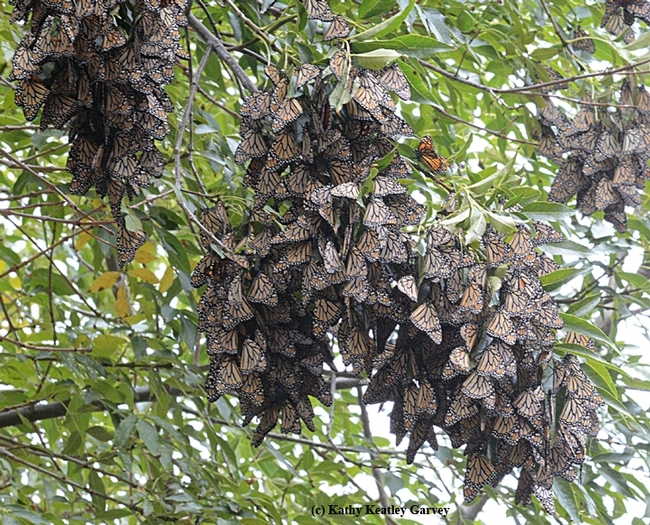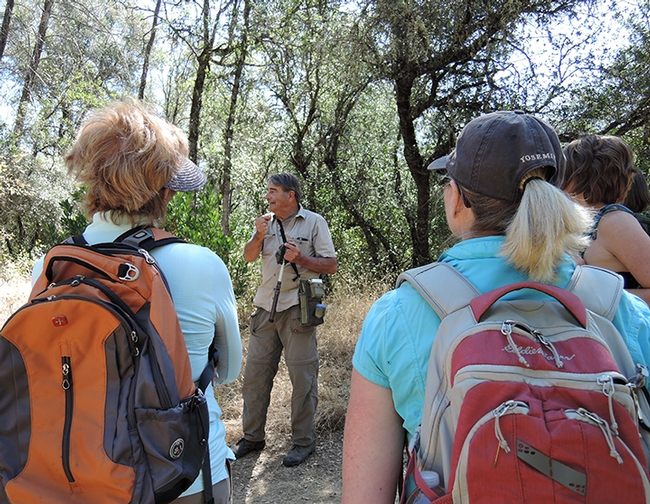- Author: Kathy Keatley Garvey
What amazing journeys!
For the last two months, migratory monarch butterflies have regularly stopped for flight fuel in our 600-square-foot pollinator garden in Vacaville, Calif. to nectar on Mexican sunflower (Tithonia), butterfly bush (Buddleia) and Lantana.
At any given time--morning and afternoon throughout September and October--we'd see four and five in the garden. A veritable migratory corridor! A veritable visual feast!
Now it's November, and we haven't seen any for a week. They've probably already reached their destination--overwintering sites in the area, including Santa Cruz and Pacific Grove.
On Labor Day, we photographed a tagged one, part of the research project of David James, entomologist at Washington State University. (See Bug Squad blog; WSU News story by Linda Seiford; and a Daily Evergreen piece by reporter Haley Donwerth on the Vacaville find. ABC, Channel 10, Sacramento, also covered "Why does this butterfly have a sticker on it?", interviewing butterfly expert Art Shapiro, UC Davis distinguished professor of evolution and ecology.
It's exciting to read the reports on the Monarchs in the Pacific Northwest Facebook page, as the tagged monarchs are photographed and recorded. Several recent entries:
- Nov. 7: "Two new tag recoveries from California! Both are currently in the Lighthouse Field, Santa Cruz overwintering colony (currently numbering about 7000) and both were found by John Dayton. The tagged Monarch (shown on the page) has flown at least 750 miles from Redmond, WA where it was reared and released on September 20 by Connie Grandberg. This is the first recovery of a Seattle-area Monarch in our program! There are now 4 PNW-tagged Monarchs residing at Lighthouse Field! We will provide information on the second new recovery once we get all the associated details."
- Nov. 7: Our second new tag recovery from Santa Cruz! This one is remarkable in that it is almost obscured from view among the other butterflies. As luck would have it, the only bit of the tag showing for John Dayton's camera is the bit with the serial number! A6935, is a female, and she was reared in Brookings in southern Oregon by Andrea Christensen and released by her at nearby Redwood Bar along the Chetco River on August 25. Santa Cruz will be Ms A6935's winter home and who knows where she will go next spring? Many thanks to Andrea and John for making this recovery possible!"
- Nov. 2: "Today we proudly announce the 9th long distance tagged Monarch recovery of this season so far! A female Monarch tag B2174 was found on November 1 at Morro Bay State Beach by Regena Orr a biologist with CA State Parks. B2174 was among about 350 clustering Monarchs and has travelled an estimated 792 miles since September 8 when it was released in Yakima, Washington! This Monarch was reared by Cindy Dunbar as part of a rearing program between PNW Monarchs and Cowiche Canyon Conservancy. 152 monarchs were reared by the 14 members of this group in 2016 and this is the first recovery for the group Congratulations! This Monarch now holds the record of the longest distance traveled by a Yakima-released Monarch. The photo shows a silhouetted group of Monarchs at Morro Bay in 2015."
Stay tuned. And stay focused with your camera! You might see a tagged one at an overwintering site.
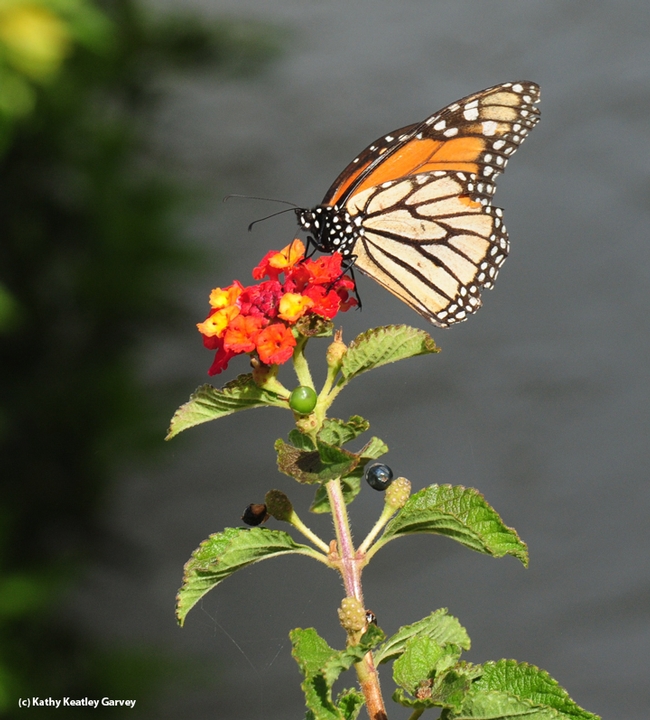
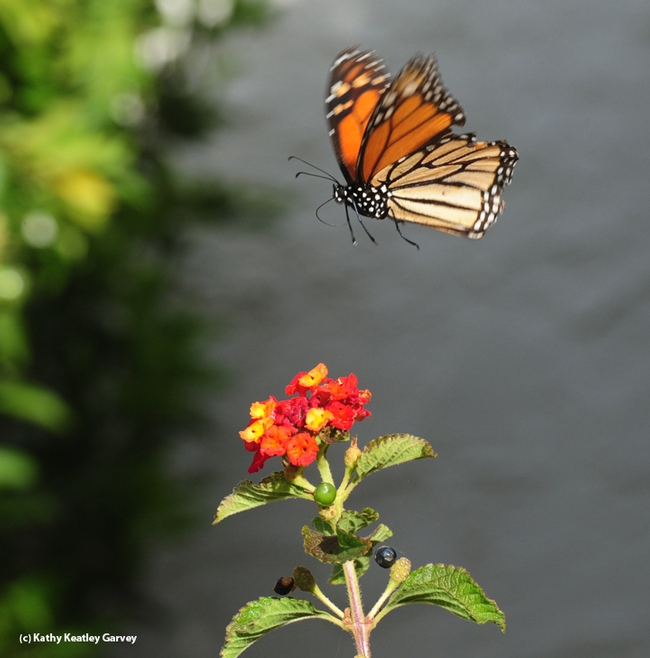
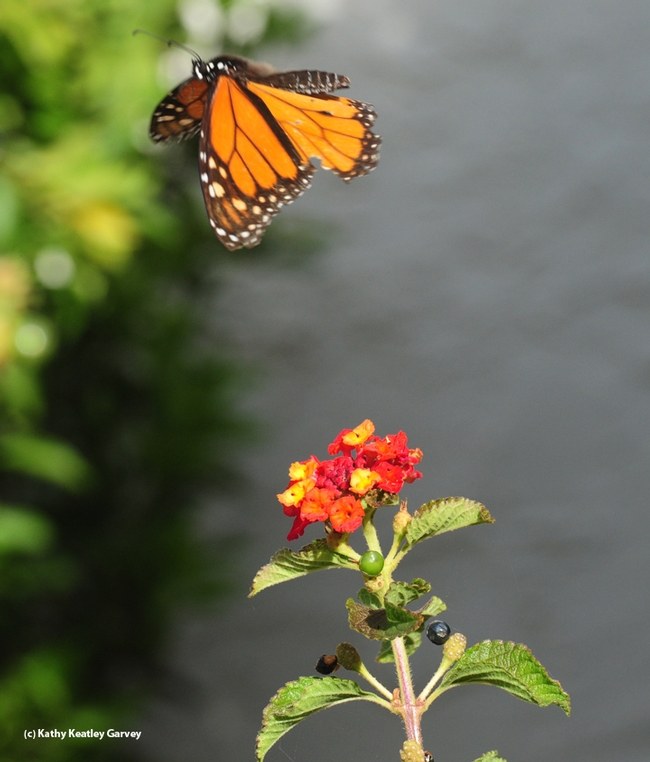
- Author: Kathy Keatley Garvey
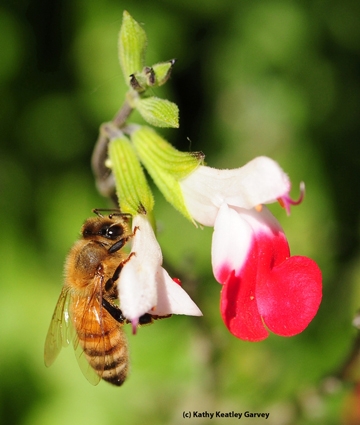
If you're looking for plants to attract pollinators, including bees and butterflies, then the UC Davis Arboretum's Plant Sale on Saturday, Oct. 22 is the place to "bee."
A public fall clearance sale will be held from 9 a.m. to 1 p.m. at the Arboretum Teaching Nursery on Garrod Drive, UC Davis campus. It will feature a "wide selection of Arboretum All-Stars, California natives, and gorgeous drought-tolerant plants," officials said. Members (new members can join at the door) save 10 percent and also reap other benefits.
The sale will include more than 16,500 plants and more than 450 varieties.
Will they have milkweed? Yes.
"It looks like we'll have plenty of milkweed, two varieties--Kotolo (Asclepias eriocarpa) and showy milkweed (Asclepias speciosa)," said Katie Hetrick, director of communications.
Will they have butterfly bush (Buddleia)? Yes.
"We have a ton of Buddleia," said Hetrick, mentioning just a few: Magenta Munchkin, Dark Dynasty, Buzz, Orchid Annie, Purple Haze, Lavender Cupcake--and "The Chips": Lilac Chip, Pink Micro Chip, and Blue Chip Jr.
"And let's not forget all the Salvias!" Hetrick said. "Those are a nectar fave with pollinators including butterflies, bees and hummingbirds!" Among the Salvias on sale: Bee's Bliss, Pacific Blue, Marine Blue, Pozo Blue, Debbie's Rose, Little Kiss, Red Swing, Violet Riot, Royal Bumble, Hot Lips, and Scott's Red.
Taylor Lewis, UC Davis Arboretum and Public Garden Nursery Manager, related that pipevine, the host plant of the pipevine swallowtail butterfly (Battus philenor), will be available.
Ellen Zagory, director of horticulture, listed some of her favorite sunflower family plants that attendees can buy:
- Aster 'Monch'
- Coreopsis, 'Little Penny'
- Coreopsis, 'Enchanted Eve'
- Coreopsis, 'Red Elf'
- Echibeckia, 'Summerina Brown'
- And lots of Echinacea (cone flowers)
For a full list of the plants available, download the PDF.
And, it's interesting to see what folks in the area have planted instead of lawns. The Aboretum's web page offers great ideas.
Do you know how much acres in the United States are planted in lawn? Huffington Post reports in a 2015 news story: "According to a new study from NASA scientists in collaboration with researchers in the Mountain West, there is now an estimated total of 163,812 square kilometers, or more than 63,000 square miles, of lawn in America — about the size of Texas."
All that manicuring, all that water, all that work. And little or no food or shelter for the pollinators.
Every well-manicured lawn "uses up to 900 liters of water per person per day and reduces sequestration effectiveness by up to 35 percent by adding emissions from fertilization and the operation of mowing equipment," Huffington Post says.
Indeed, lawn is our nation's single largest "crop."
But it doesn't have to be. There IS life after lawn. And there is MORE life after lawn.
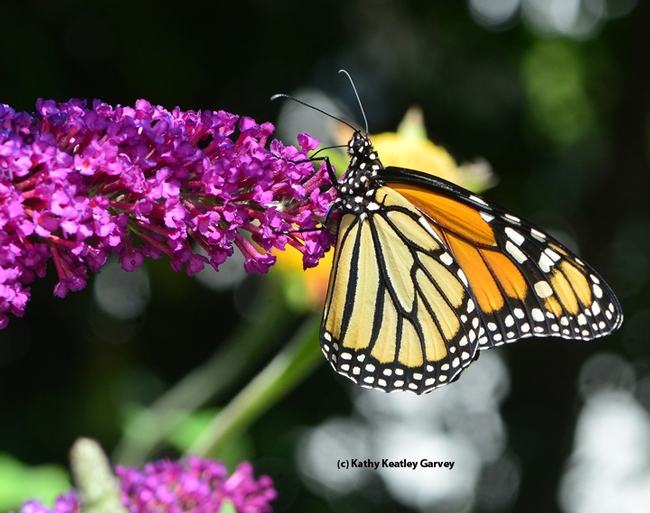
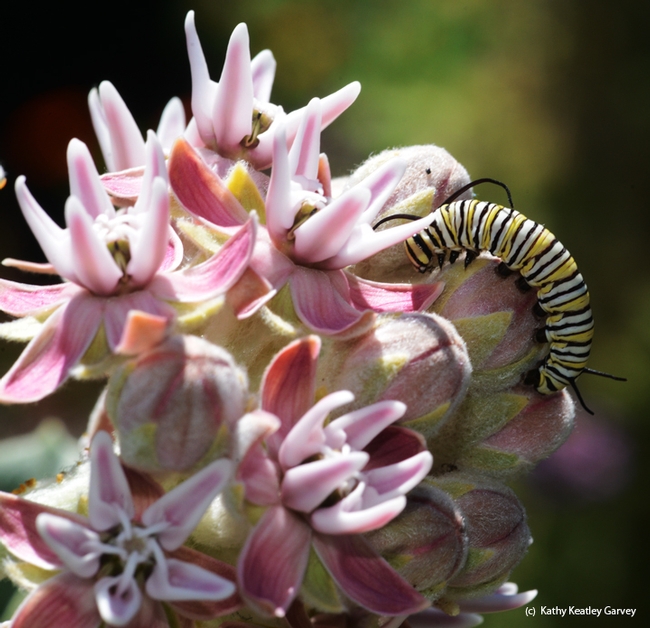
- Author: Kathy Keatley Garvey
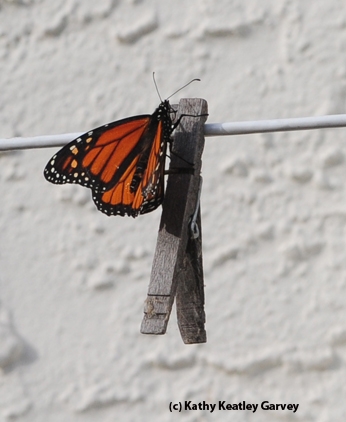
In the Pacific Northwest, they're heading for coastal California, including Santa Cruz and Pacific Grove, for their overwintering spots.
A few are tagged. Washington State University entomologist David James and his citizen scientists have tagged some with "monarch@wsu.edu" with a serial number. Look for them! Better yet, photograph them. And then contact him.
We've seen one WSU-tagged monarch in Vacaville so far (he was tagged and released by citizen scientist Steve Johnson on Aug. 28 in Ashland, Ore. and fluttered into our pollinator garden on Sept. 5), but many more butterflies are migrating through.
One of the monarchs in James' program was photographed on a San Francisco rooftop on Sept. 18 and seen again Oct. 11 in an overwintering colony in Santa Cruz. It was tagged and released by Molly Monroe and her 5-year-old daughter, Amelia, on Aug. 30 in Corvallis, Ore. Oregon Live did a piece on this.
James says this may give hope that the Steve Johnson progeny/Vacaville surprise "may well be found in one of the overwintering colonies this winter!" The entomologist and his family will be searching for tags in overwintering colonies from Santa Barbara to Bolinas from Nov 19-26.
Check out the "Monarch Butterflies in the Pacific Northwest" Facebook page for more amazing stories.
Meanwhile, migrating monarchs continue to make pit stops for flight fuel in our yard. Some look weathered and torn, no thanks to the inclement weather and cunning predators. Some look as if they're on their last legs...er...wings. They all look hungry. Nectar! Nectar! We need nectar!
We spotted a male nectaring on a Mexican sunflower (Tithonia) and minutes later, a female touched down on the same flower. The scene reminded us of an exquisite painting. Autumn's reigning colors gracing a one-of-a-kind canvas.
Then came the wonder of wonders: a monarch headed for the clothesline and snuggled up to a clothespin.
Let's hope that wasn't the bottom line...
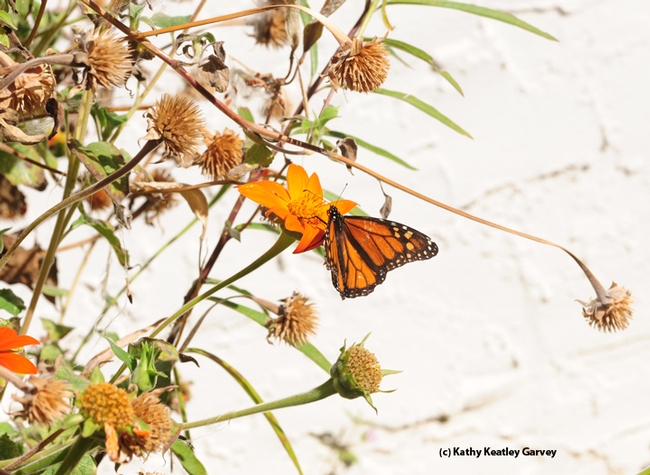
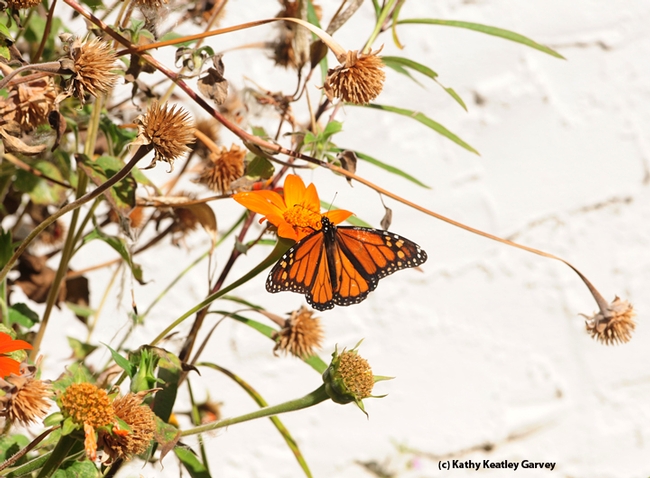
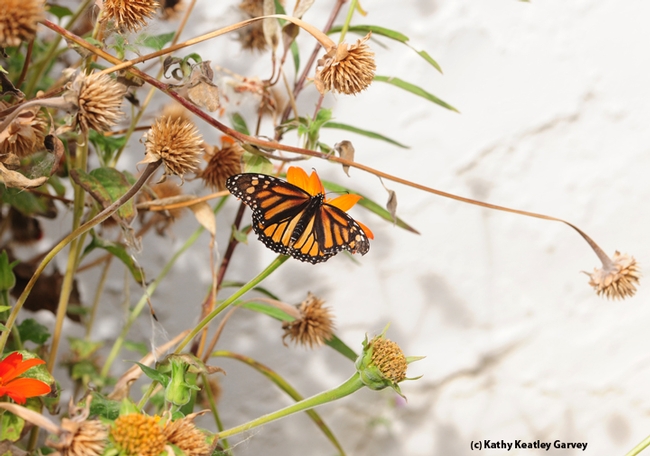
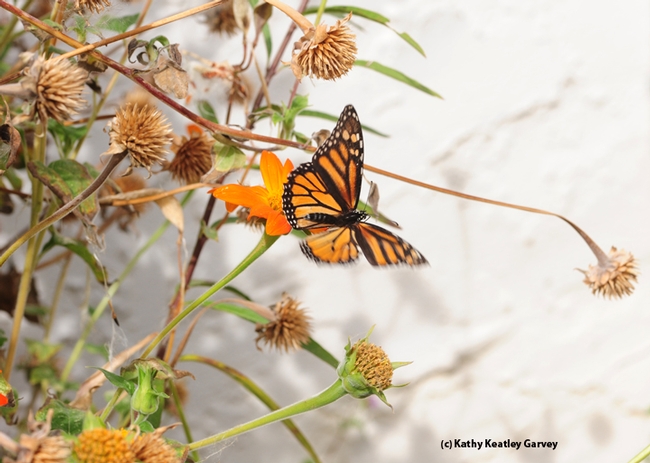
- Author: Kathy Keatley Garvey
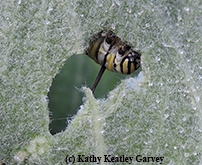
Monarch butterflies are migrating now, but we're still finding a few caterpillars in our pollinator garden in Vacaville, Calif.
We recently plucked off five caterpillars from our milkweed plants (our game plan is protect them from California scrub jays and other birds, tachinid flies, wasps and the protozoan parasite, Ophryocystis elektroscirrha or OE, for short).
These are the last 'cats of the season.
Ours is a small-scale conservation project. Our goal is to reach 50 by the end of the season. We're on track to do our small part for the declining monarch population. Plant milkweed (the host plant of monarchs), plant nectar-rich flowers such as Mexican sunflower (Tithonia), butterfly bush (Buddleia) and Lantana, and Danaus plexippus will come.
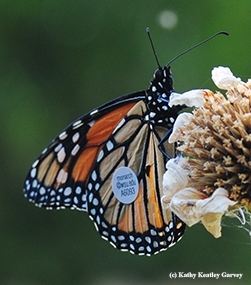
https://news.wsu.edu/2016/10/03/southbound-stopover-monarch-butterfly-big-surprise/
Weiford works inside the French Administration Building, named for former president C. Clement French. When I joined the Daily Evergreen news staff--way back when!--I used to interview Dr. French.
Small world.
And it became even smaller when the WSU-tagged monarch (monarch@wsu.edu), part of WSU entomologist David James' research program, stopped by for a visit. It was reared by citizen scientist Steve Johnson of Ashland, and tagged and released on Sunday, Aug. 28. "So, assuming it didn't travel much on the day you saw it, it flew 285 miles in 7 days or about 40.7 miles per day," James said. "Pretty amazing."
Yes, pretty amazing, indeed.
Now, with any luck--well, lots of luck--Steve Johnson's progeny has made its way to an overwintering colony in Santa Cruz or Pacific Grove.
And with any more luck, we'll be adding five more to the overwintering site.


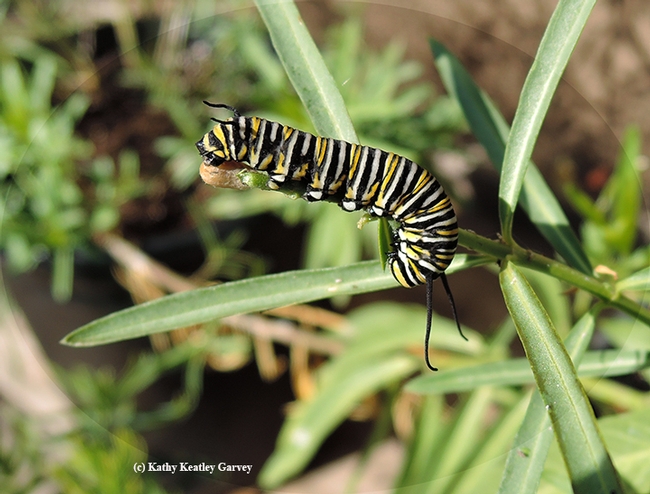
- Author: Kathy Keatley Garvey

When we drove to Santa Cruz on Dec. 27, 2014 to an overwintering site, we saw a monarch cluster 80 feet up--80 feet up, up and away--in a eucalyptus tree. We never saw a single tag. Then on Nov. 30, 2015 we drove to the Berkeley Aquatic Park to see a monarch cluster, 25 feet high in an ash tree. We never saw a single tag.
So it was really amazing, as recounted in a previous Bug Squad blog, to find and photograph a tagged monarch in our own backyard. The male monarch, tagged monarch@wsu.edu, A6093 and part of entomologist David James' research program at Washington State University, fluttered into our yard in Vacaville, Calif. on Monday, Sept. 5.
We later learned that citizen-scientist Steve Johnson of Ashland, Ore., a member of the Southern Oregon Monarchs Advocates, tagged and released the male monarch on Sunday, Aug. 28. So, the monarch flew 285 miles in seven days or about 40.7 miles per day, James pointed out. And it's one of his earliest recoveries.
But back to sightings of tagged migrating monarchs.
We asked butterfly guru, Art Shapiro, UC Davis distinguished professor of evolution and ecology, how many tagged migrating butterflies he's seen. He's studied the Central California population of butterflies—not just monarchs—for more than four decades, and is out in the field at least 200 days a year. A fellow of the American Association for the Advancement of Science, the Royal Entomological Society and the California Academy of Sciences, Shapiro maintains a website on butterflies at http://butterfly.ucdavis.edu/, where he records the population trends he monitors in Central California. He wrote A Field Guide to Butterflies of the San Francisco Bay and Sacramento Valley Regions, illustrated by artist Tim Manolis and published in 2007 by the University of California Press.
So, how many tagged monarchs has Art Shapiro seen in the field? "I've only seen one tagged one in the past decade--at Gates Canyon (Vacaville)," he said, "but it was too far away to read the tag, alas."
Curious, we asked a few other UC Davis scientists who study monarchs how many they have seen.
- Hugh Dingle, emeritus professor of entomology, none.
- Louie Yang, associate professor of entomology, none.
- Greg Kareofelas, an associate of the Bohart Museum of Entomology, two.
Karefoelas spotted his first tagged monarch on Table Mountain, Butte County “but it was a long time ago," he said. "It was long before I had a digital camera, so no pic."
Kareofelas sighted another tagged monarch at Knights Landing, Yolo County, on April 23, 1997. He found it on his father's ranch on Road 102, just south of Knights Landing. It was a male monarch, with the serial number #58984, tagged Jan. 29, 1997 at an overwintering site in Santa Barbara.
Kareofelas notified research project leader Walter Sakai, a biology professor at Santa Monica College, who thanked him for the find. Where exactly was it tagged? At Santa Barbara's Ellwood Main, located just west of the UC Santa Barbara campus in Goleta. In a letter to Kareofelas, Sakai wrote: “This is the furthest distance a tagged migrating monarch has traveled from our 1996-97 tagging effort. The second furthest was to Groveland near Yosemite. This recovery will be one piece of the puzzle in understanding the spring migration phenomenon of monarch butterflies."
Meanwhile, the Pacific Northwest monarch migration to coastal California continues through the end of October. Keep a lookout for a WSU-tagged monarch. If you find one (and be sure to photograph it, if you can) contact James at monarch@wsu.edu.
